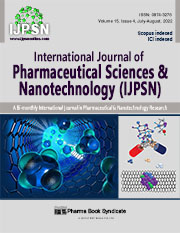Formulation Development, Evaluation and Statistical Optimization of the Release Rate of Oral Sustained Release Matrix Tablet of Aceclofena
DOI:
https://doi.org/10.37285/ijpsn.2022.15.4.2Abstract
Aim: This work aimed to develop a sustained released hydrophilic matrix tablet of Aceclofenac for better therapeutic action.
Background: Conventional dosage form didn't provide the desired level of drug release. Even many-marketed sustained-release tablets didn't always meet the satisfactory level of drug release. It was a challenging job for pharmaceutical scientists to develop a well-sustained release formulation. Keeping this perspective in mind a robust sustained release formulation was designed, developed and optimized with nontoxic, inert viscoelastic, semisynthetic polymers which will be accepted worldwide.
Objective: The objective of this research was to develop an Aceclofenac sustained released matrix tablet, which will deliver the desired level of drug release.
Method: Aceclofenac sustained released tablet was prepared with Methocel K-100M Premium (Hydroxypropyl Methylcellulose) and Unigel 270 (Pregelatinized starch). These two excipients were selected as independent formulation variables with three separate levels (high, intermediate and low). Nine batches of hydrophilic matrix tablets of Aceclofenac were prepared according to the 32 Factorial Design with an average weight of 365 mg/tablet. Each prepared batch of tablets was then evaluated for drug content, physical parameters and drug release. Mathematical models were then generated using Analysis of Variance employing Design-Expert Software version 8.0.7.1 for % cumulative release at T1 hr, T4 hr and T7 hr. FTIR spectroscopy was carried out to evaluate drug-excipients interaction after formulation.
Results: Design-Expert Software after analyzing the release data of prepared 9 batches provides an optimized composition of formulation. The optimized batch showed desirable results for cumulative % release (CPR)T1hr, CPR T4hr and CPR T7hr are 35.61, 52.16 and 61.98 respectively.
Conclusion: Application of statistical experimental design, the physicochemical studies and the in vitro-release study, the mathematically predicted formulation and its manufacturing and validation of aceclofenac sustained-release tablets showed great advancement from the trial-and-error method of development of sustained-release drug delivery systems.
Downloads
Metrics
Keywords:
Aceclofenac, Sustained-release, 32 factorial design, Statistical optimizationDownloads
Published
How to Cite
Issue
Section
References
Das B, Manna A, Chakraborty D and Deb, S (2006). Application of simplex centroid design for the preparation of hydrophilic matrix tablets of diclofenac sodium and statistical optimization of release rate. Journal of Scientific & Industrial Research 65: 725-728.
Deshmukh RK and Naik JB (2015). The impact of preparation parameters on sustained release aceclofenac microspheres: A design of experiments. Advanced Powder Technolog 26(1): 244-252.
Gupta CR, Kishore GK and Ratna JV (2013). Development and evaluation of aceclofenac matrix tablets using polyethylene oxides as sustained release polymers. Journal of pharmacy research 6(2): 249-254.
Jana S, Sen KK and Basu SK (2014). In vitro aceclofenac release from IPN matrix tablets composed of chitosan-tamarind seed polysaccharide. International journal of biological macromolecules 65: 241-245.
Kang WH, Van Nguyen H, Park C, Choi YW and Lee BJ (2017). Modulation of microenvironmental pH for dual release and reduced in vivo gastrointestinal bleeding of aceclofenac using hydroxypropyl methylcellulose-based bilayered matrix tablet. European Journal of Pharmaceutical Sciences 102: 85-93.
Koirala S, Nepal P, Ghimire G, Basnet R, Rawat I, Dahal A and Parajuli-Baral K (2021). Formulation and evaluation of mucoadhesive buccal tablets of aceclofenac. Heliyon 7(3): e06439.
Montgomery DC (1996). Design and Analysis of Experiments, 4th ed. John Wiley & Sons Publishers, New York, pp 67-69, 436- 453.
Nandi G, Nandi AK, Khan NS, Pal S and Dey S (2018). Tamarind seed gum-hydrolyzed polymethacrylamide-g–gellan beads for extended release of diclofenac sodium using 32 full factorial design. International journal of biological macromolecules 114: 214-225.
Ofori-Kwakye K, Mfoafo KA, Kipo SL, Kuntworbe N, and El Boakye-Gyasi M (2016). Development and evaluation of natural gum-based extended release matrix tablets of two model drugs of different water solubilities by direct compression. Saudi Pharmaceutical Journal 24(1): 82-91.
Pharmacopoeia I (2018). The Indian Pharmacopoeia Commission Ghaziabad Vol. II.
Shah V, Hathi G, Misra M and Nivsarkar M (2022). Design, development and QbD based optimization of double coated spheronized aceclofenac pellets for effective palliative care in rheumatoid arthritis. Journal of Drug Delivery Science and Technology 67: 102920.
Van Nguyen H and Lee BJ (2016). Dual release and molecular mechanism of bilayered aceclofenac tablet using polymer mixture. International Journal of Pharmaceutics 515(1-2): 233-244.
Wu IY, Bala S, Škalko-Basnet N, and Di Cagno MP (2019). Interpreting non-linear drug diffusion data: Utilizing Korsmeyer-Peppas model to study drug release from liposomes. European journal of pharmaceutical sciences 138: 105026.
Zhai XJ, Yu Y, Chen F and Lu YN (2013). Comparative bioavailability and tolerability of single and multiple doses of 2 diclofenac sodium sustained-release tablet formulations in fasting, healthy chinese male volunteers. Current Therapeutic Research 75: 53-58.






